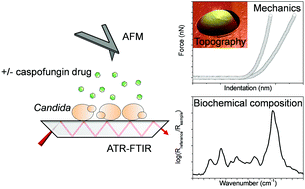Our official English website, www.x-mol.net, welcomes your feedback! (Note: you will need to create a separate account there.)
AFM combined to ATR-FTIR reveals Candida cell wall changes under caspofungin treatment
Nanoscale ( IF 6.7 ) Pub Date : 2017-09-04 00:00:00 , DOI: 10.1039/c7nr02170d Fabienne Quilès 1, 2, 3, 4, 5 , Isabelle Accoceberry 1, 6, 7, 8, 9 , Célia Couzigou 1, 6, 7, 8, 9 , Grégory Francius 1, 2, 3, 4, 5 , Thierry Noël 1, 6, 7, 8, 9 , Sofiane El-Kirat-Chatel 1, 2, 3, 4, 5
Nanoscale ( IF 6.7 ) Pub Date : 2017-09-04 00:00:00 , DOI: 10.1039/c7nr02170d Fabienne Quilès 1, 2, 3, 4, 5 , Isabelle Accoceberry 1, 6, 7, 8, 9 , Célia Couzigou 1, 6, 7, 8, 9 , Grégory Francius 1, 2, 3, 4, 5 , Thierry Noël 1, 6, 7, 8, 9 , Sofiane El-Kirat-Chatel 1, 2, 3, 4, 5
Affiliation

|
Fungal pathogens from Candida genus are responsible for severe life-threatening infections and the antifungal arsenal is still limited. Caspofungin, an antifungal drug used for human therapy, acts as a blocking agent of the cell wall synthesis by inhibiting the β-1,3-glucan-synthase encoded by FKS genes. Despite its efficiency, the number of genetic mutants that are resistant to caspofungin is increasing. An important challenge to improve antifungal therapy is to understand cellular phenomenon that are associated with drug resistance. Here we used atomic force microscopy (AFM) combined to Fourier transform infrared spectroscopy in attenuated total reflection mode (ATR-FTIR) to decipher the effect of low and high drug concentration on the morphology, mechanics and cell wall composition of two Candida strains, one susceptible and one resistant to caspofungin. Our results confirm that caspofungin induces a dramatic cell wall remodelling via activation of stress responses, even at high drug concentration. Additionally, we highlighted unexpected changes related to drug resistance, suggesting that caspofungin resistance associated with FKS gene mutations comes from a combination of effects: (i) an overall remodelling of yeast cell wall composition; and (ii) cell wall stiffening through chitin synthesis. This work demonstrates that AFM combined to ATR-FTIR is a valuable approach to understand at the molecular scale the biological mechanisms associated with drug resistance.
中文翻译:

AFM与ATR-FTIR结合可显示卡泊芬净治疗下念珠菌细胞壁的变化
念珠菌属的真菌病原体导致严重的威胁生命的感染,而抗真菌药库仍然有限。卡泊芬净是一种用于人类治疗的抗真菌药物,它通过抑制FKS基因编码的β-1,3-葡聚糖合酶,作为细胞壁合成的阻断剂。尽管具有效率,但是对卡泊芬净具有抗性的遗传突变体的数量正在增加。改善抗真菌治疗的一项重要挑战是了解与耐药性相关的细胞现象。在这里,我们使用原子力显微镜(AFM)结合傅里叶变换红外光谱以衰减全反射模式(ATR-FTIR)来解释高低浓度药物对两种药物的形态,力学和细胞壁组成的影响念珠菌菌株,一种易感,另一种对卡泊芬净具有抗性。我们的结果证实,即使在高药物浓度下,卡泊芬净也能通过激活应激反应来诱导细胞壁重塑。此外,我们强调了与耐药性有关的意想不到的变化,表明与FKS基因突变相关的卡泊芬净耐药性来自多种作用的组合:(i)酵母细胞壁组成的整体重塑;(ii)通过几丁质合成使细胞壁变硬。这项工作表明,将AFM与ATR-FTIR结合使用是在分子水平上了解与耐药性相关的生物学机制的有价值的方法。
更新日期:2017-09-21
中文翻译:

AFM与ATR-FTIR结合可显示卡泊芬净治疗下念珠菌细胞壁的变化
念珠菌属的真菌病原体导致严重的威胁生命的感染,而抗真菌药库仍然有限。卡泊芬净是一种用于人类治疗的抗真菌药物,它通过抑制FKS基因编码的β-1,3-葡聚糖合酶,作为细胞壁合成的阻断剂。尽管具有效率,但是对卡泊芬净具有抗性的遗传突变体的数量正在增加。改善抗真菌治疗的一项重要挑战是了解与耐药性相关的细胞现象。在这里,我们使用原子力显微镜(AFM)结合傅里叶变换红外光谱以衰减全反射模式(ATR-FTIR)来解释高低浓度药物对两种药物的形态,力学和细胞壁组成的影响念珠菌菌株,一种易感,另一种对卡泊芬净具有抗性。我们的结果证实,即使在高药物浓度下,卡泊芬净也能通过激活应激反应来诱导细胞壁重塑。此外,我们强调了与耐药性有关的意想不到的变化,表明与FKS基因突变相关的卡泊芬净耐药性来自多种作用的组合:(i)酵母细胞壁组成的整体重塑;(ii)通过几丁质合成使细胞壁变硬。这项工作表明,将AFM与ATR-FTIR结合使用是在分子水平上了解与耐药性相关的生物学机制的有价值的方法。



























 京公网安备 11010802027423号
京公网安备 11010802027423号